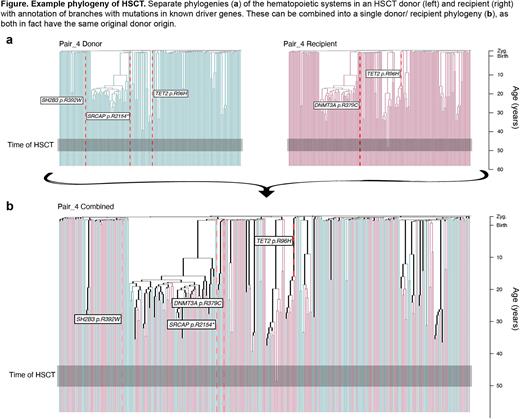Abstract
Background Allogeneic hematopoietic stem cell transplantation (HSCT) is a potentially curative treatment received by over 40,000 patients/year. Despite being an established treatment for 50 years, fundamental questions remain about the dynamics of long-term stem cell engraftment and immunological reconstitution in humans. How many of the >108 transplanted CD34+ cells contribute to long-term hematopoiesis? How does increasing age of donor and recipient reshape clonal dynamics of HSCT? Are the same HSCs responsible for both myeloid and lymphoid reconstitution? Does HSCT increase mutation rates or clonal evolution?
Methods We used spontaneous somatic mutations occurring genome-wide in single hematopoietic stem and progenitor cells (HSPCs) to reconstruct high-resolution lineage trees of the hematopoietic system after HSCT. We analysed blood samples from both the donor (D) and recipient (R) for 10 HLA-matched sibling HSCTs - the duration of time elapsed since transplant ranged from 9 to 31 years, meaning that we could study genuinely long-term reconstitution in the recipient, compared to the unperturbed hematopoiesis in the donor. For each individual (D and R), peripheral blood CD34+ HSPC-derived colonies were grown on methylcellulose medium. Whole genome sequencing was performed on 100-300 colonies per individual, generating a final dataset of 3,413 genomes. Somatic mutations from each colony's founder cell were identified and used to build phylogenies for each D/R pair (Figure). For 7/10 pairs, we then used ultra-deep targeted sequencing to assess clonal contributions in sorted mature D/R cell subsets, including monocytes, B-cells and T-cells. Approximate Bayesian computation was used to estimate numbers of engrafting HSCs.
RESULTS
In most cases, 10,000 - 50,000 HSCs engrafted and contributed to long-term reconstitution during HSCT. However, grafts from older donors, or those with lower CD34+ cell doses tended to have lower estimates, some as low as <1,000 cells.
Recipients had decreased clonal diversity compared to their donors, equivalent to 8-10 years of additional ageing.
We detected 93 individual clones that contributed >1% of the population of at least one mature cell type. Each of these expanded clones was detectable in both the donor and the recipient, confirming that they had originated prior to HSCT.
Only ~10% of these expanded clones carried mutations in genes known to contribute to clonal hematopoiesis, suggesting that there are many other genes that can influence stem cell dynamics after HSCT.
The sizes of these expanded clones often varied dramatically between donors and recipients, up to 25-fold differences in some instances.
The population bottleneck caused by HSCT was not sufficient to explain the differences in clonal composition between recipient and donor, suggesting that there are additional HSCT-specific selective pressures during stem cell harvest, in vitro manipulation, infusion, homing and engraftment.
While large proportions of mature myeloid and B-cell populations usually derived from the identified clones, this was not true for T-cell populations. This suggests that following HSCT, T-cells are largely derived from stem cells that do not contribute substantially to myeloid reconstitution.
HSPC mutation burdens in recipients were similar to their donors, contradicting previous hypotheses that the proliferative stress of HSCT would lead to excess mutations.
CONCLUSION Our findings reveal that tens of thousands of HSCs typically engraft during HSCT, but with significant loss of clonal diversity in recipients compared to their unperturbed donors. HSCT-specific selective pressures shape dynamics of hematopoietic reconstitution in the recipient, with substantial differences in clonal composition between myeloid and T-lymphoid populations. This study shows the power of using somatic mutations as clonal marks for lineage tracing in real-world HSCT in humans, an approach we believe will be a new gold standard for understanding the impact of different stem cell sources and transplant protocols.
Disclosures
Manz:University of Zurich: Patents & Royalties: CD117xCD3 TEA; CDR-Life Inc: Consultancy, Current holder of stock options in a privately-held company. Campbell:FL86 Inc: Consultancy, Other: Founder.
Author notes
Asterisk with author names denotes non-ASH members.


This feature is available to Subscribers Only
Sign In or Create an Account Close Modal